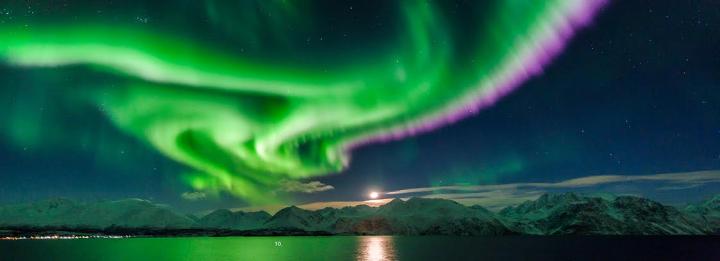Team led by graduate student at PPPL produces unique simulation of magnetic reconnection

Northern lights as seen over Norway. Credit: Jan R. Olsen
The new simulation captures the physics of magnetic reconnection, the breaking apart and snapping together of the magnetic field lines in plasma that occurs throughout the universe. The simulations approximate kinetic effects in a fluid code, which treats plasma as a flowing liquid, to create a more detailed picture of the reconnection process.
Previous simulations used fluid codes to produce simplified descriptions of reconnection that takes place in the vastness of space, where widely separated plasma particles rarely collide. However, this collisionless environment gives rise to kinetic effects on plasma behavior that fluid models cannot normally capture.
Estimation of kinetic behavior
The new simulation estimates kinetic behavior. “This is the first application of this particular fluid model in studying reconnection physics in space plasmas,” said Ng, lead author of the findings reported in August in the journal Physics of Plasmas.
Ng and coauthors approximated kinetic effects with a series of fluid equations based on plasma density, momentum and pressure. They concluded the process through a mathematical technique called “closure” that enabled them to describe the kinetic mixing of particles from non-local, or large-scale, regions. The type of closure involved was originally developed by PPPL physicist Greg Hammett and the late Rip Perkins in the context of fusion plasmas, making its application to the space plasma environment an example of fruitful cross-fertilization.
The completed results agreed better with kinetic models as compared with simulations produced by traditional fluid codes. The new simulations could extend understanding of reconnection to whole regions of space such as the magnetosphere, the magnetic field that surrounds the Earth, and provide a more comprehensive view of the universal process.
###
Coauthoring the paper were physicists Ammar Hakim of PPPL and Amitava Bhattacharjee, head of the Theory Department at PPPL and a professor of astrophysical sciences at Princeton University, together with physicists Adam Stanier and William Daughton of Los Alamos National Laboratory. Support for this work comes from the DOE Office of Science, the National Science Foundation and NASA. Computation was performed at the National Energy Research Scientific Computer Center, a DOE Office of Science User Facility, and the University of New Hampshire.
PPPL, on Princeton University's Forrestal Campus in Plainsboro, N.J., is devoted to creating new knowledge about the physics of plasmas — ultra-hot, charged gases — and to developing practical solutions for the creation of fusion energy. The Laboratory is managed by the University for the U.S. Department of Energy's Office of Science, which is the largest single supporter of basic research in the physical sciences in the United States, and is working to address some of the most pressing challenges of our time. For more information, please visit science.energy.gov.
Media Contact
All latest news from the category: Physics and Astronomy
This area deals with the fundamental laws and building blocks of nature and how they interact, the properties and the behavior of matter, and research into space and time and their structures.
innovations-report provides in-depth reports and articles on subjects such as astrophysics, laser technologies, nuclear, quantum, particle and solid-state physics, nanotechnologies, planetary research and findings (Mars, Venus) and developments related to the Hubble Telescope.
Newest articles

“Nanostitches” enable lighter and tougher composite materials
In research that may lead to next-generation airplanes and spacecraft, MIT engineers used carbon nanotubes to prevent cracking in multilayered composites. To save on fuel and reduce aircraft emissions, engineers…

Trash to treasure
Researchers turn metal waste into catalyst for hydrogen. Scientists have found a way to transform metal waste into a highly efficient catalyst to make hydrogen from water, a discovery that…

Real-time detection of infectious disease viruses
… by searching for molecular fingerprinting. A research team consisting of Professor Kyoung-Duck Park and Taeyoung Moon and Huitae Joo, PhD candidates, from the Department of Physics at Pohang University…





















